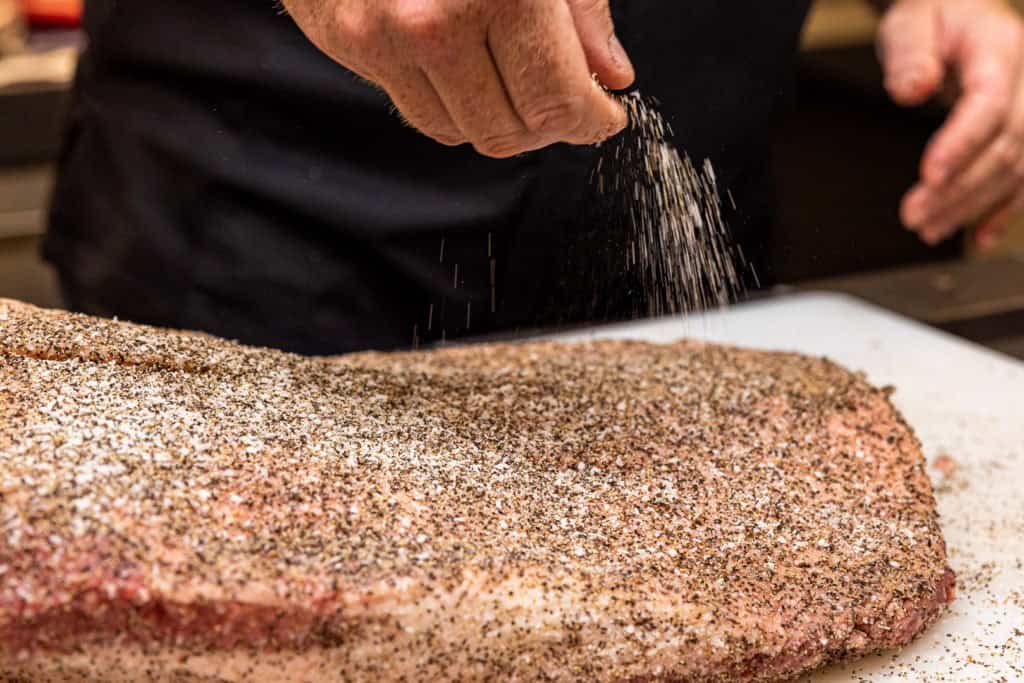
Introduction
Understanding Brisket Texture
Brisket is a revered cut of meat in the world of barbecue, but its texture is often misunderstood. Understanding brisket texture begins with recognizing its unique composition. Brisket contains a significant amount of connective tissue, primarily collagen, which gives it a tough, fibrous nature at first glance. However, this toughness is also what makes it so special; when cooked correctly, collagen breaks down into gelatin, resulting in that melt-in-your-mouth tenderness that countless BBQ enthusiasts seek.
- Collagen Breakdown: As brisket cooks low and slow, the magic happens—collagen transforms into gelatin, enriching the meat’s flavor and tenderness.
- Melt-in-your-mouth quality: A properly cooked brisket doesn’t just feel tender; it practically dissolves in the mouth, creating a delightful eating experience.
Significance of Texture in Brisket Cooking
The texture of brisket plays a crucial role in the overall dining experience. A well-cooked brisket goes beyond flavor; it’s about creating the perfect bite that’s tender yet retains enough structure to provide satisfaction. Think of it this way:
- Tender yet Structured: The ideal brisket should be tender enough to pull apart, yet firm enough to hold its shape when sliced.
- Juicy and Flavorful: The right texture ensures that every slice is bursting with the rich flavors developed during the cooking process.
Achieving this texture requires patience, skill, and an understanding of the science behind cooking—a journey any BBQ lover can embark upon for mouthwatering results.
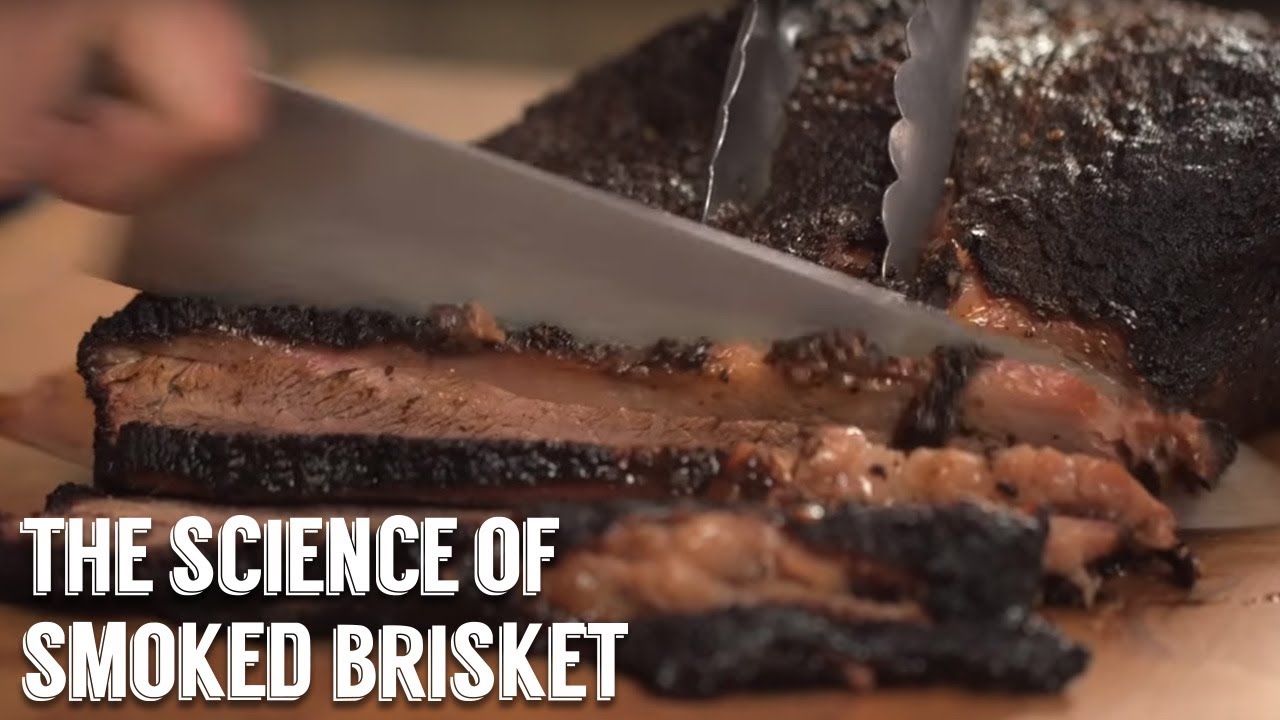
The Science of Brisket Texture
Composition of Brisket Meat
Understanding the composition of brisket meat is crucial for creating that perfect texture that all BBQ lovers crave. Brisket is a cut derived from the breast or lower chest of cattle, making it rich in connective tissue, particularly collagen. This collagen plays a significant role in how the brisket cooks and ultimately how it tastes.
- Collagen Content: Brisket contains a substantial amount of collagen, which is initially tough and fibrous.
- Intramuscular Fat: In addition to collagen, brisket has intramuscular fat, or marbling, that contributes to flavor and tenderness.
This combination of tough connective tissue and fat can transform into a tender, juicy delight when cooked correctly. The key is to be patient and allow time for the collagen to break down into gelatin, a process that enhances both tenderness and mouthfeel.
Effects of Cooking Methods on Texture
Cooking methods significantly influence the final texture of brisket. Here are some popular techniques:
- Low and Slow Cooking: By cooking brisket at temperatures around 225-250°F (107-121°C), the collagen effectively breaks down, resulting in a tender texture.
- Hot and Fast Cooking: Cooking at higher temperatures (300-350°F) can yield different textural results, often leading to a firmer bite.
For example, a brisket cooked low and slow may take 10-12 hours, while a hot and fast method might only require a fraction of the time but can compromise tenderness.
- Resting Period: Remember, letting the brisket rest post-cooking is just as important. It allows the juices to redistribute, ensuring each bite remains succulent.
By mastering these cooking methods and understanding the composition of brisket, anyone can elevate their brisket game to achieve that ideal melt-in-the-mouth experience.
Factors Influencing Brisket Texture
Time and Temperature
When it comes to achieving the perfect brisket texture, time and temperature are your best friends. The secret lies in low and slow cooking, a method that allows collagen to break down into gelatin, which results in that tender experience we all crave.
- Optimal Temperature: Keeping your smoker at 225-250°F (107-121°C) is ideal. At these low temperatures, the brisket gradually cooks, giving the connective tissue time to break down.
- Cooking Duration: Plan for about 1 to 1.5 hours per pound of brisket. The patience can be challenging, but it’s crucial to avoid the temptation to rush the process.
For instance, I once tried cooking a brisket on higher heat, thinking it would save time. The result? A tough and chewy disappointment!
Resting Period Post-Cooking
Believe it or not, resting is just as important as cooking. After pulling your brisket from the smoker, allow it to rest for at least 30 minutes. This resting phase lets the juices redistribute throughout the meat, which enhances moisture and flavor.
- Ideal Resting Time: While 30 minutes is the minimum, resting for an hour will yield even better results.
- Wrapping Techniques: Wrapping the brisket in foil or butcher paper can help retain heat and moisture during this resting period.
I remember slicing into a brisket too soon once; it was dry and devoid of flavor—definitely a learning moment.
Type of Wood Used for Smoking
The type of wood you choose for smoking has a profound impact on the flavor and texture of the brisket. Each wood type contributes its unique characteristics.
- Hickory and Mesquite: These hardwoods provide a strong, robust flavor that pairs perfectly with the rich profile of brisket.
- Fruit Woods: On the other hand, fruit woods like apple or cherry impart a milder, sweeter taste, which can elevate the overall flavor experience.
For the best results, consider mixing different woods to achieve a unique flavor profile. I always prefer a combination of hickory and apple wood; it creates a delightful balance between robust and sweet, enhancing the brisket’s natural flavors without overwhelming it.
By carefully managing the time, temperature, resting period, and choice of wood, you can create a brisket that is not just good, but truly exceptional.
Techniques to Achieve Desired Texture
Slow Smoking Method
The slow smoking method is the cornerstone technique for achieving a perfectly textured brisket. This method capitalizes on low and slow cooking, allowing the brisket to break down collagen effectively while absorbing rich, smoky flavors.
- Ideal Temperature: Maintain a smoker temperature of 225-250°F (107-121°C).
- Timing: Typically, you’ll want to allocate 1 to 1.5 hours per pound of brisket. The longer cooking time allows collagen to turn into gelatin, which provides that melt-in-your-mouth experience.
I remember the first time I tried a low-smoking approach—it was a game-changer. The difference in tenderness was astonishing!
Wrapping in Foil during Cooking
Wrapping the brisket in foil during the cooking process can elevate its tenderness by creating a steamy environment that helps breakdown tough fibers. This technique is often utilized during the “stall,” when the internal temperature plateaus.
- The Texas Crutch: This method involves wrapping the brisket tightly in foil when it reaches a temperature of around 160°F (71°C), which can accelerate the cooking process and lock in moisture.
Using foil not only saves time but ensures a juicy final product that slices easily. I’ve found that wrapping my brisket consistently yields a juicy outcome that impresses every time.
Marinating and Seasoning Tips
Proper seasoning is essential to enhance the natural flavors of the brisket and contribute to its texture. Here are some tips to keep in mind:
- Marinades: A simple marinade with acidic components like vinegar or citrus can help tenderize the meat.
- Dry Rub: A classic mix of salt and pepper is popular, but adding garlic powder, onion powder, and paprika can elevate the flavor profile.
Typically, I apply my seasoning and let the brisket sit at room temperature for about 30 minutes before smoking. It allows the seasonings to penetrate, ensuring every bite bursts with flavor.
By employing these techniques—slow smoking, wrapping during cooking, and using flavorful marinades and rubs—you’ll set yourself up for brisket success, achieving the tender and juicy texture that makes this cut of meat so beloved.
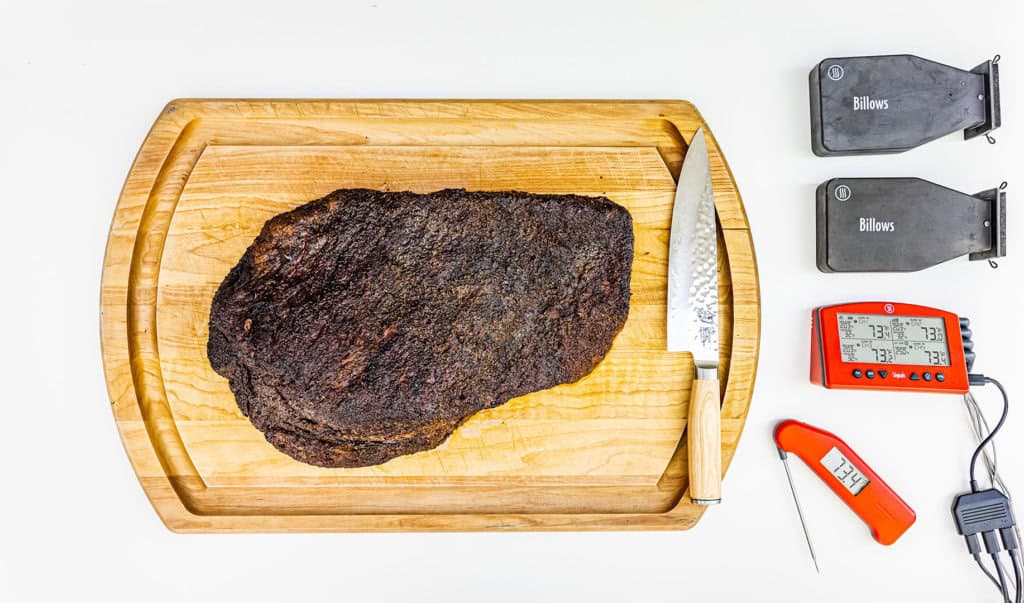
Considerations for Different Texture Preferences
Tender and Juicy Brisket
When it comes to brisket, nothing beats that tender, juicy bite that leaves your taste buds singing. To achieve this ideal texture, several elements must come into play.
- Cooking Method: Aim for the low and slow cooking technique, keeping your smoker at a steady 225-250°F (107-121°C) for several hours. The goal is to allow the collagen to break down properly and create that melt-in-your-mouth experience.
- Resting Period: Don’t skip the resting phase! Allow the brisket to rest for at least 30 minutes after cooking. This step is crucial for reabsorbing juices that enhance moisture and flavor.
I still remember the first tender brisket I made: letting it rest transformed what could have been a dry mistake into an absolute crowd-pleaser!
Firm and Sliced Brisket
For those who prefer a firmer texture in their brisket, perhaps for slicing and serving at gatherings, you can take a different approach.
- Cooking Temperature: Cooking at a slightly higher temperature, around 250-275°F (121-135°C), can yield a firmer result. This method helps to maintain more structural integrity while still cooking through the meat.
- Slicing Technique: Ensure that you slice against the grain, which can prevent chewiness and make for easier eating. Thicker cuts may be preferred if you enjoy a more substantial bite.
I’ve found that thicker slices of brisket tend to hold up better on a platter during gatherings, allowing guests to enjoy the meat without it falling apart too easily.
By tailoring your cooking method and slicing technique based on personal texture preferences, you can ensure that each brisket you serve meets the desires of your family and friends. Whether tender or firm, the right approach can truly elevate your barbecue game!
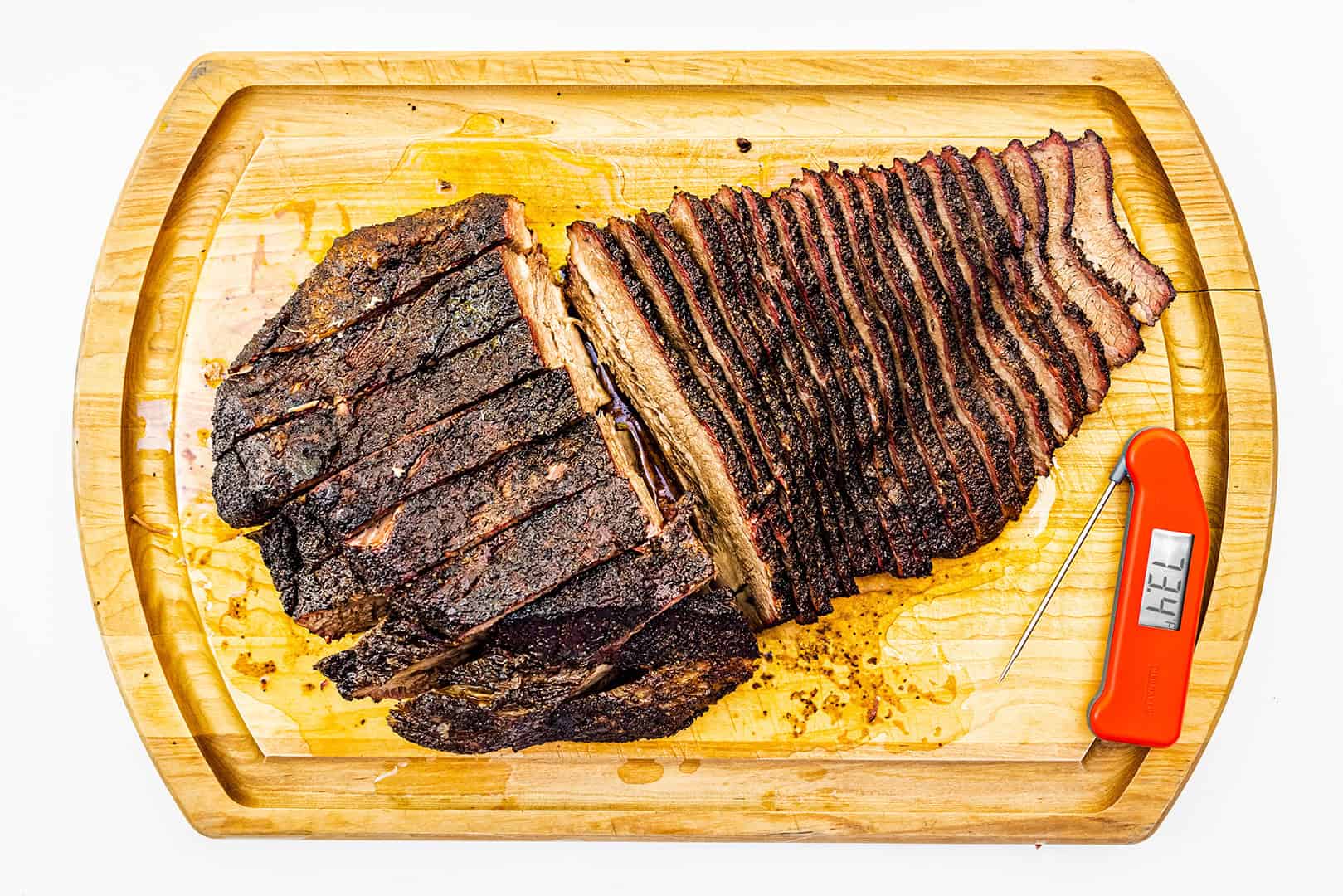
Tools and Equipment for Texture Control
Meat Thermometers
One of the most essential tools for achieving the desired texture in your brisket is a reliable meat thermometer. Consistent cooking temperatures can be challenging to manage, especially with larger cuts of meat like brisket.
- Types of Thermometers: Consider using an instant-read thermometer for quick checks or a probe thermometer that stays in the meat while it cooks. The latter can notify you when your brisket hits the ideal temperature.
- Optimal Temperature Range: Aim for an internal temperature of around 195-205°F (90-96°C) for the best texture, as this range signifies that collagen has broken down effectively.
I can’t stress enough how many times I’ve avoided disappointing results thanks to my trusty thermometer—no more guessing games!
Smokers and Grills
The type of smoker or grill you choose can make a significant difference in your brisket’s final texture. Different cooking methods can yield completely different results.
- Wood-Fired Smokers: These provide the best flavor and texture, as they allow for that beloved low and slow cooking method.
- Pellet Grills: If you love convenience, pellet grills are perfect for maintaining consistent temperatures with minimal effort, making them an excellent option for beginners.
I remember using a traditional offset smoker for my first brisket; while it took more attention to control heat, the end results were absolutely worth it.
Resting and Holding Containers
After cooking, proper resting is key to achieving juicy and tender brisket. Here’s where your resting and holding containers come into play.
- Insulated Containers: Use a cooler or an insulated container to wrap your brisket after cooking. This helps retain heat and moisture while the meat rests.
- Resting Period: Aim for at least 30 minutes of resting, but I often recommend letting it rest for up to an hour to achieve maximum juiciness.
This resting phase can truly be the difference between a good brisket and a great one—allowing those flavors to meld and juices to redistribute is essential for a mouthwatering experience.
By utilizing the right tools and techniques, you can master the art of brisket smoking and consistently create the perfect texture every time. Enjoy the journey and the delicious results!
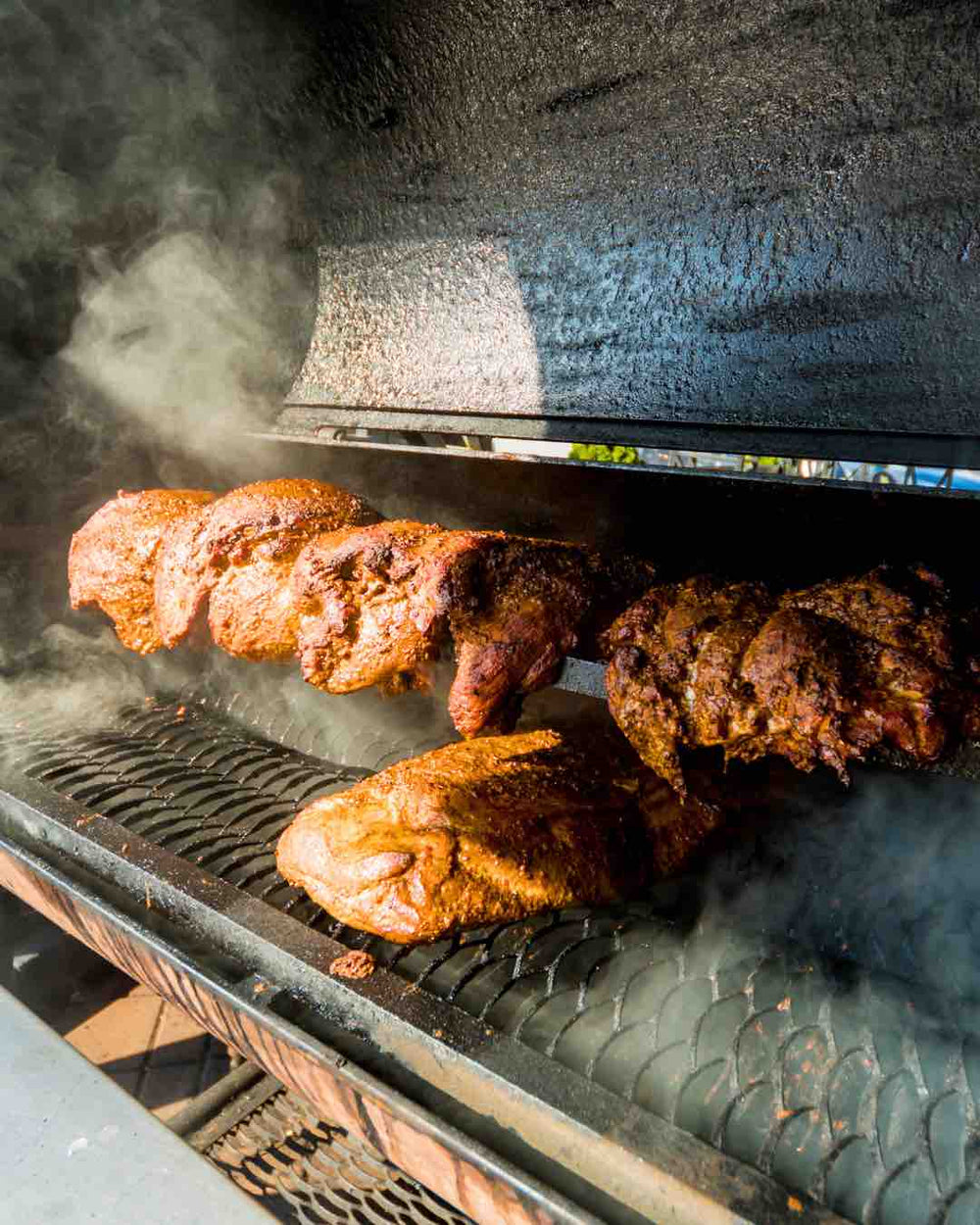
Conclusion
Recap of Texture Science
Understanding the science behind brisket texture is crucial for achieving the ultimate barbecue experience. The key players in this process are collagen and the way it breaks down through low and slow cooking. As you cook brisket at a consistent temperature—ideally between 225°F and 250°F (107°C to 121°C)—the collagen transforms into gelatin, creating that desired melt-in-your-mouth tenderness.
- Chemical Transformations: The Maillard reaction not only develops complex flavors but also contributes to that beautiful crust we all love on the outside of brisket.
- Cooking Duration: Remember, the process requires patience! Quick cooking usually leads to tough results, while the right time allows for a perfect balance of tenderness and juiciness.
Final Tips for Perfect Brisket Texture
To ensure your brisket comes out perfect every time, consider these final tips:
- Choose Quality Cuts: Always go for brisket with good marbling and an appropriate fat cap.
- Monitor Temperature: Utilize a reliable meat thermometer to keep track of cooking temperature and avoid under or overcooking.
- Don’t Rush Resting: Let your brisket rest adequately post-cooking to lock in moisture and enhance flavor. A minimum of 30 minutes is ideal.
I’ve learned through trial and error that small details can make the biggest difference. So, gather your tools and embrace the art of smoking brisket. With patience and practice, each attempt can lead to a perfectly textured masterpiece that impresses your guests and satisfies your cravings!

Leave a Reply